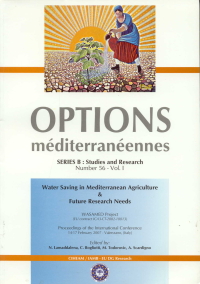| Article précédent | p. 261-276 | Article suivant |
Effect of drip irrigation regimes on yield and quality of field grown bell pepper
In this study, carried out in 2002 and 2003 in Turkey, three irrigation intervals (I1:18-22 mm, I2:38-42 mm and I3:58-62 mm of cumulative pan evaporation from Class A pan) and three plantpan coefficients (Kcp1=0.50, Kcp2=0.75 and Kcp3=1.00) were evaluated. Irrigation intervals varied from 3-6 days in I1, 6-11 days in I2 and 9-15 days in I3 treatments. Maximum and minimum yields were obtained from the I1Kcp3 and I3Kcp1 treatments as 33140 kg ha-1 and 21620 kg ha-1 in 2002 and 35298 kg ha-1 and 21010 kg ha-1 in 2003, respectively. As the Kcp value decreased the total yields each irrigation interval also decreased. However, with the lower irrigation frequency (I3), lower yields were obtained with all Kcp coefficients. Seasonal water use values in the treatments varied from 365 mm in I2Kcp1 to 528 mm in I1Kcp3 in 2002 and 309 mm in I3Kcp1 to 511 mm in I1Kcp3 in 2003. Significant second degree polynomial relations were found between pepper yield and total water use. Water use efficiency (WUE) and irrigation water use efficiency (IWUE) values were influenced by the irrigation intervals and plant-pan coefficients. WUE ranged from 4.7 kg m-3 in I3Kcp2 to 7.6 kg m-3 in the I1Kcp1 in the 2002 growing season and ranged from 6.4 kg m-3 in I3Kcp3 to 7.9 kg m-3 in the I2Kcp2 in the 2003 growing season. Maximum IWUE was observed in I1Kcp1, and minimum IWUE was in I3Kcp3 treatment in the 2002 and 2003 growing seasons. Both Kcp coefficients (irrigation amounts) and irrigation frequencies had different effects on quality parameters such as number of fruit, mean fruit weight, pepper length and width, as well as stem diameter and plant height at harvest. In conclusion, I1Kcp3 irrigation regime is recommended for field grown bell pepper.
Dans cette étude, menée en 2002 et 2003 en Turquie trois régimes différents d'irrigation ont été utilisés (valeurs d'évaporation cumulative classe A Pan : I1:18-22 mm, I2:38-42 mm, I3: 58-62 mm) et trois coefficients plante-pan(kcp1=0.50, kcp2=0.75, kcp3=1.00). Les intervalles d'irrigation étaient de 3-6 jours pour I1, 6-11 jours pour I2, 9-15 jours pour I3. En 2002, les productions maximale et minimale de 33140 kg ha-1 et de 21620 kh ha-1 ont été obtenues avec les traitements I1kcp3 et I3kcp1. En 2003, ces valeurs étaient respectivement de 35298 kg ha-1 et de 21010 kg ha-1. Pour chaque intervalle d'irrigation, lorsque la valeur kcp décroît, la production totale diminue. Toutefois, avec la fréquence d'irrigation la plus basse (I3), on a obtenu les plus faibles productions quel que soit le coefficient kcp. Les valeurs de consommation d'eau saisonnière(ET) varient de 365 mm pour I2kcp1 à 528 mm pour I1kcp3 en 2002 et de 309 mm pour I1kcp3 à 511 mm pour I1kcp3 en 2003. Des relations polynomiales significatives de second degré ont été trouvées entre la production de poivrons et la consommation totale d'eau. Le WUE varie de 4.7 kg m-3 pour I3kcp2 à 7.6 kg m-3 au cours de l'année 2002 et de 6.4 kg m-3 pour I3kcp3 à 7.9 kg m-3 avec le traitement I2kcp2 appliqué en 2003. La valeur maximale IWUE a été observée avec I1kcp1, et minimale avec I3kcp3 . Les coefficients kcp et les fréquences d'irrigation ont des effets différents sur des paramètres de qualité tels que notamment le nombre ou le poids des fruits ainsi que sur le diamètre et la hauteur de la plante à la récolte. En conclusion, le régime d'irrigation recommandé pour la production de poivron en plein champ est I1kcp3.
- [ Afficher ]
- [ Télécharger ]
- [ Exporter la citation ]
Vous pouvez télécharger la citation au format :
- [ Imprimer ]
-
Mots-clés
CAPSICUM ANNUUM, DOSE D'IRRIGATION, EFFICACITE, EVAPORATION, IRRIGATION GOUTTE A GOUTTE, QUALITE, RENDEMENT DES CULTURES, TURQUIE, UTILISATION DE L'EAUCiter cet article
Sezen S.M., Yazar A., Eker S. Effect of drip irrigation regimes on yield and quality of field grown bell pepper. In : Lamaddalena N. (ed.), Bogliotti C. (ed.), Todorovic M. (ed.), Scardigno A. (ed.). Water saving in Mediterranean agriculture and future research needs [Vol. 1]. Bari : CIHEAM, 2007. p. 261-276. (Options Méditerranéennes : Série B. Etudes et Recherches; n. 56 Vol.I). Proceedings of the International Conference WASAMED Project (EU contract ICA3-CT-2002-10013), 2007/02/14-17, Valenzano (Italy). http://om.ciheam.org/om/pdf/b56_1/00800118.pdf



